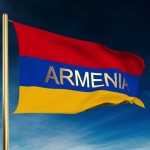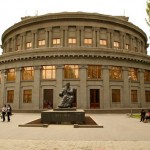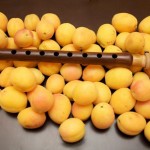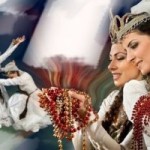
National Holidays in Armenia
Comment are off
January 1, 2- New Year – is celebrated a whole week after the holiday which starts on December 31, by baking New Year cookies and with a table laden with food and different kind of sweets. During this week people exchange gifts with congratulations and their houses are open to welcome everyone.
January 23-(in 2016 year) – St. Sargis– is a beloved religious observance and is very popular among you ng people. It is celebrated 63 days before Easter, on a Saturday falling sometime between January 18 and February 23. On thenight of the holiday young people eat salty pies and don’t drink water to encourage dreaming at night. They believe that St. Sargis decides their fate, that the person who gives them water to drink in their dreams will become their future spouse. People also put a plate with flour outside their homes to have a record of St. Sargis’s horse riding through the flour. They believe St. Sargis appears with lightening speed on his radiant horse, and that the traces left on the flour serve as a good sign to bring them luck. In people’s imagination St. Sargis is handsome and appears with a spear, a gold helmet and gold armor.
ng people. It is celebrated 63 days before Easter, on a Saturday falling sometime between January 18 and February 23. On thenight of the holiday young people eat salty pies and don’t drink water to encourage dreaming at night. They believe that St. Sargis decides their fate, that the person who gives them water to drink in their dreams will become their future spouse. People also put a plate with flour outside their homes to have a record of St. Sargis’s horse riding through the flour. They believe St. Sargis appears with lightening speed on his radiant horse, and that the traces left on the flour serve as a good sign to bring them luck. In people’s imagination St. Sargis is handsome and appears with a spear, a gold helmet and gold armor.
January 28– National Army Day – Armenian National Army was created in 1992.
February 14– Trnde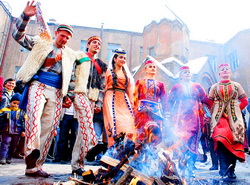 z– This holiday is celebrated every year on February 14. It is like St. Valentine’s Day, and the main participants are young couples. The main symbol of the action is a fire over which people are jumping. It is necessaryto hold hands while jumping for the union to be strong.
z– This holiday is celebrated every year on February 14. It is like St. Valentine’s Day, and the main participants are young couples. The main symbol of the action is a fire over which people are jumping. It is necessaryto hold hands while jumping for the union to be strong.
March 8– Women’s Day – International Day of Women is very popular among Armenians. All women get presents and flowers from their family, friends and colleagues.
March 27(in 2016 year) – Easter (Zatik) –Zatik (Easter) is the favorite and the most anticipated holiday in the Christian world. Everybody greets each other on th is day: “Christ has arisen”-“Blessed is the resurrection of Christ». Armenians have preserved the beautiful biblical lore which refers to red eggs and cheorek (sweet bread): “When Christ was crucified, his mother took some eggs and bread wrapped in the shawl. When the Mother saw her Son crucified and his arms bleeding, she knelt down and cried. The Mother’s tears and Son’s blood dropping on the shawl colored the eggs and bread. Then the Mother put the shawl on her head. Since that day people began coloring eggs red on Easter day and women began wearing shawls when visiting church.
is day: “Christ has arisen”-“Blessed is the resurrection of Christ». Armenians have preserved the beautiful biblical lore which refers to red eggs and cheorek (sweet bread): “When Christ was crucified, his mother took some eggs and bread wrapped in the shawl. When the Mother saw her Son crucified and his arms bleeding, she knelt down and cried. The Mother’s tears and Son’s blood dropping on the shawl colored the eggs and bread. Then the Mother put the shawl on her head. Since that day people began coloring eggs red on Easter day and women began wearing shawls when visiting church.
April 7 –Day of Maternity and Beauty – This day is also dedicated to women. Mothers receive gifts and flowers from their children. The period from March 8th to April 7th is considered the Month of Women.
May 9– Victory and Peace Day – The Victory of World War II and the Memorial for its dead is an official holiday in Armenia. On this day the heroes of WW II march through the Republic Square.
May 28 –Day of the First Republic – In 1918 the Republic of Armenia restored its statehood after half a millennium of lost sovereignty.
July 3 – (in 2015 year) – Vardavar –also known in Christian tradition as Transfiguration of Jesus Christ, is o ne of the most popular and biggest holidays in Armenia, which is now celebrated 98 days after the Easter. The ancient legend says that there was a rich man who demanded young beauties as slaves for using the water he owned. But brave young man Vardan defeated that miscreant and liberated girls. So, on that day people douche themselves and others. As centuries ago, today people start to have fun pouring water on everyone from the morning, and usually nobody is offended for that.
ne of the most popular and biggest holidays in Armenia, which is now celebrated 98 days after the Easter. The ancient legend says that there was a rich man who demanded young beauties as slaves for using the water he owned. But brave young man Vardan defeated that miscreant and liberated girls. So, on that day people douche themselves and others. As centuries ago, today people start to have fun pouring water on everyone from the morning, and usually nobody is offended for that.
July 5– Constitution Day – The Constitution of the Republic of Armenia was adopted through a national referendum on July 5, 1995.
September 21- Independence Day – The third Republic of Armenia announced the results of a national referendum on secession from Soviet Union in 1991.
August 14 – Grape Blessing Day – this holiday is celebrated on the nearest Sunday of August 15. Catholicos of Armenian Church blesses t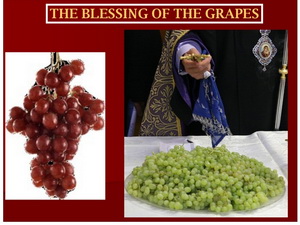 he grape harvest.Traditionally, the Armenian Apostolic Church holds a ceremony of grapes’ blessing on the day of the Feast of the Assumption of the Holy Mother of God. The ceremony takes place immediately after the Divine Liturgy. Of the vast varieties of produce, grapes had a special place of honor and were considered the “first fruits”, because they were the first produce of harvest.
he grape harvest.Traditionally, the Armenian Apostolic Church holds a ceremony of grapes’ blessing on the day of the Feast of the Assumption of the Holy Mother of God. The ceremony takes place immediately after the Divine Liturgy. Of the vast varieties of produce, grapes had a special place of honor and were considered the “first fruits”, because they were the first produce of harvest.

